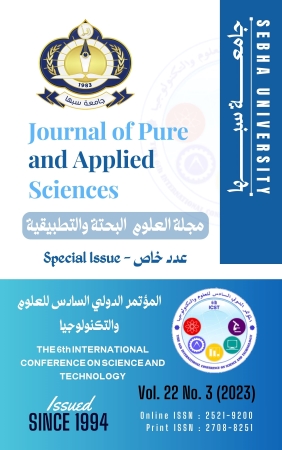Identifying the most important problems of cultivating some of the soils of Umm Al-Ghazlan, west of Sebha- Libya
Abstract
This study was conducted in Um Al-Ghazlan area located in the western side of Sebha city. Four profiles were chosen to represent the soil of the region. The morphological properties of the soil showed a clear similarity between them, such as the depth of the soil being within the depth limits (less than 100 cm). The soil contains a light pale, surface diagnostic horizon (Ochric horizon). Its color is light (yellow). The predominant texture is sandy, silty-sandy, and silty-sandy. It was clear from the chemical analysis that it is very affected byؤؤ salts, especially in the surface layer, for all profiles. And Soil pH range at between 7.7 to 9.6, as well as a high percentage of cations and anions, and total calcium carbonate in high proportions reaching (18.75%), as in the first profile at 20-30 cm and the fourth profile at (60 to 90 cm), with the appearance of calcium carbonate in The shape of stones or the shape of a carbonate and spongy slab on the surface, especially in the fourth profile .It was found that the classification of the sectors at a level below the major group of the American classification falls under one classification units : Typic torriorthents. And the soil of the region suffers from some cultivation problems, such as the high amount of salts, the degree of reaction, the light texture, and the percentage of calcium carbonate in the soil. As a result of soil conditions and characteristics. And the influence of the prevailing climate on the one hand, in addition to the depletion of some elements by the plant. The agricultural investment of the soil of this site requires reclamation operations before planting, to raise its productive capacity, starting with the soil washing process, in addition to removing or scraping the calcium carbonate present as stones. before the planting process. In order to decide on this subject, further study must be conducted.
Full text article
Authors
Copyright (c) 2023 Journal of Pure & Applied Sciences

This work is licensed under a Creative Commons Attribution 4.0 International License.
In a brief statement, the rights relate to the publication and distribution of research published in the journal of the University of Sebha where authors who have published their articles in the journal of the university of Sebha should how they can use or distribute their articles. They reserve all their rights to the published works, such as (but not limited to) the following rights:
- Copyright and other property rights related to the article, such as patent rights.
- Research published in the journal of the University of Sebha and used in its future works, including lectures and books, the right to reproduce articles for their own purposes, and the right to self-archive their articles.
- The right to enter a separate article, or for a non-exclusive distribution of their article with an acknowledgment of its initial publication in the journal of Sebha University.
Privacy Statement The names and e-mail addresses entered on the Sabha University Journal site will be used for the aforementioned purposes only and for which they were used.





